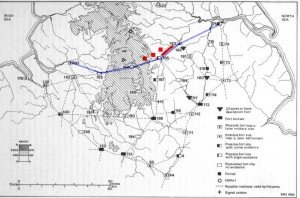The Gallus Frontier – Roman Rig and associated Iron Age Forts The Gallus frontier, outlined in blue, south of the line, the Roman fortifications, to the north, Venutius’ kingdom. The Frontier changes made by Gallus In “Rome against Caratacus” Graham Webster put forward the proposal that Gallus was forced to remodel the existing …
Category: Archaeology
Sep 25
Guide – Mining Glossary
Mining Terms Adit or Drift A tunnel driven from the surface underground or driven between seams. Used for pumping, transport, ventillation and manriding. Afterdamp Description given to the gases (noxious) remaining in a mine after an explosion, usually with a high content of Carbon Dioxide Anvil Stone In early mining activities, ores were crushed by …
Sep 25
Guide – Bronze Age Mining
Mining in the Bronze Age In the last twenty years or so, some thirty copper mining sites of Bronze Age date have been identified. This has allowed us to create a reasonably accurate picture of the tools and techniques used during the extraction of copper ores in this distant prehistoric period. It is only recently …
Sep 25
Guide – Mining
Guide to Mining This section illustrates the history of mining and aims to give sufficient information for a researcher to be able to recognise mining features and to be able to identify the periods of working on a site. Mine works are an extensive subject, complicated by the use of different terms for similar features, …
Sep 25
Guide – Resistivity
Archaeology Techniques Resistivity The electrical resistance of the Ground is almost entirely dependant upon the amount and distribution of moisture within it. Buried remains affect this distribution and can be detected with instruments. Stone, for example, is more moisture resistant than a clay subsoil or the filling of a ditch. These resistivity differences can be …
Sep 25
Guide – Hidden Remains
Hidden Remains Identification of features is simplified when the full extent of remains such as earthworks, can be easily seen. However, once the roof has gone, the walls perished or robbed, the interior burnt and the wreck left to perish for hundreds of years, the remainder flattened and used as a field for crops, the …
Sep 25
Guide – Visible Remains
Visible Remains “The identity of an earthwork can be determined to a certain extent by the shape of the field marking that is left. If it is square or rectangular with rounded comers, it is highly likely that the constructors were from the Roman army. If it is an irregular quadrilateral with a gateway on …
Sep 25
Guide – Glossary
Glossary of prehistoric features This section was compiled with the help of the English Heritage NMR record. It currently includes descriptions for those Military, Domestic and Agricultural features that would have been in existence up to the Roman Period in Britain. Primary Name Alternate Name(s) Description ALTAR An elevated table or podium on which to …
Sep 25
Guide – Desktop
A Guide to DIY archaeology The Desktop Search Virtually all archaeological investigations begin with a desktop search of one form or another, the term desktop search simply means the sort of research you can do from a desk. Assuming that you have read the first section of this guide, you will already know about the …



